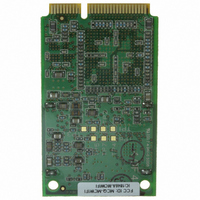101-1284 Rabbit Semiconductor, 101-1284 Datasheet - Page 22

101-1284
Manufacturer Part Number
101-1284
Description
DEV KIT STANDARD MINI RCM5600W
Manufacturer
Rabbit Semiconductor
Series
MiniCore™r
Type
Transceiver, 802.11 b/gr
Datasheet
1.101-1285.pdf
(130 pages)
Specifications of 101-1284
Frequency
2.4GHz
Wireless Frequency
2.4 GHz
Interface Type
USB
Operating Voltage
3.3 V
Output Power
19 dBm
Antenna
U.FL Connector
Operating Temperature Range
- 30 C to + 55 C
Silicon Manufacturer
Rabbit Semiconductor
Silicon Family Name
RabbitCore
Kit Contents
Board
Features
On-board Single-Chip 802.11b/g Transceiver, Built-In Web Server
Development Tool Type
Hardware /
Rohs Compliant
Yes
For Use With/related Products
RCM5600W
Lead Free Status / RoHS Status
Not applicable / Not applicable
Other names
316-1160
- Current page: 22 of 130
- Download datasheet (2Mb)
First, prepare the AC adapter for the country where it will be used by selecting the plug.
The deluxe Development Kit presently includes Canada/Japan/U.S., Australia/N.Z., U.K.,
and European style plugs. Snap in the top of the plug assembly into the slot at the top of
the AC adapter as shown in Figure 5, then press down on the spring-loaded clip below the
plug assembly to allow the plug assembly to click into place. Release the clip to secure the
plug assembly in the AC adapter.
Connect the AC adapter to DC input jack J6 on the Interface Board as shown in Figure 5.
Plug in the AC adapter. The green power LED on the Interface Board should light up. The
RCM5600W and the Interface Board are now ready to be used.
Note that the center pin of J6 is positive.
2.3 Run a Sample Program
If you already have Dynamic C installed, you are now ready to test your programming
connections by running a sample program. Start Dynamic C by double-clicking on the
Dynamic C icon on your desktop or in your
menu. Select the “Communications” tab
Start
in the Dynamic C
Options > Project Options
menu and verify that
Use USB to Serial
Converter
is selected to support the USB cable. Choose
Store Program in RAM
on the
“Compiler” tab for faster compiling when running sample programs. Click
OK
.
You may have to select the COM port assigned to the USB USB cable on your PC. In
Dynamic C, select
Options > Project Options
, then select this COM port on the “Com-
munications” tab, then click
OK
. You may type the COM port number followed by
Enter
on your computer keyboard if the COM port number is outside the range on the dropdown
menu.
Now find the WIFISCAN.C sample program in the Dynamic C Samples\WiFi folder,
open it with the File menu, then compile and run the sample program by pressing F9.
The Dynamic C
window will display
, and will display a list
STDIO
Starting scan....
of access points/ad-hoc hosts similar to the one shown here.
The following fields are shown in the Dynamic C
window.
STDIO
• Channel—the channel the access point is on (1–11).
• Signal—the signal strength of the access point.
• MAC—the hardware (MAC) address of access point.
• Access Point SSID—the SSID the access point is using.
16
MiniCore RCM5600W
Related parts for 101-1284
Image
Part Number
Description
Manufacturer
Datasheet
Request
R

Part Number:
Description:
COMPUTER SNGLBD BL2120 FRCTNLOCK
Manufacturer:
Rabbit Semiconductor
Datasheet:

Part Number:
Description:
KIT APPLCTN RABBITCORE RCM4010
Manufacturer:
Rabbit Semiconductor
Datasheet:

Part Number:
Description:
KIT MESH NETWORK ADD-ON RCM4510W
Manufacturer:
Rabbit Semiconductor
Datasheet:

Part Number:
Description:
KIT DEV FOR BL2500 COYOTE
Manufacturer:
Rabbit Semiconductor
Datasheet:

Part Number:
Description:
KIT APPLICATION SIMPLE SENSOR
Manufacturer:
Rabbit Semiconductor
Datasheet:

Part Number:
Description:
KIT DEV RCM5400W US/INTERNATIONL
Manufacturer:
Rabbit Semiconductor
Datasheet:

Part Number:
Description:
DEV KIT DELUXE MINICORE RCM5600W
Manufacturer:
Rabbit Semiconductor
Datasheet:

Part Number:
Description:
KIT FOR BL4S100 STARTER PACKAGE
Manufacturer:
Rabbit Semiconductor
Datasheet:

Part Number:
Description:
MODULE RABBITCORE RCM3720
Manufacturer:
Rabbit Semiconductor
Datasheet:

Part Number:
Description:
MODULE RABBITCORE RCM3220
Manufacturer:
Rabbit Semiconductor
Datasheet:

Part Number:
Description:
MODULE RABBITCORE RCM3210
Manufacturer:
Rabbit Semiconductor
Datasheet:

Part Number:
Description:
COMPUTER SGL-BOARD OP6600 W/SRAM
Manufacturer:
Rabbit Semiconductor
Datasheet:

Part Number:
Description:
COMPUTER SGL-BD BL2000 SRAM/FLSH
Manufacturer:
Rabbit Semiconductor











